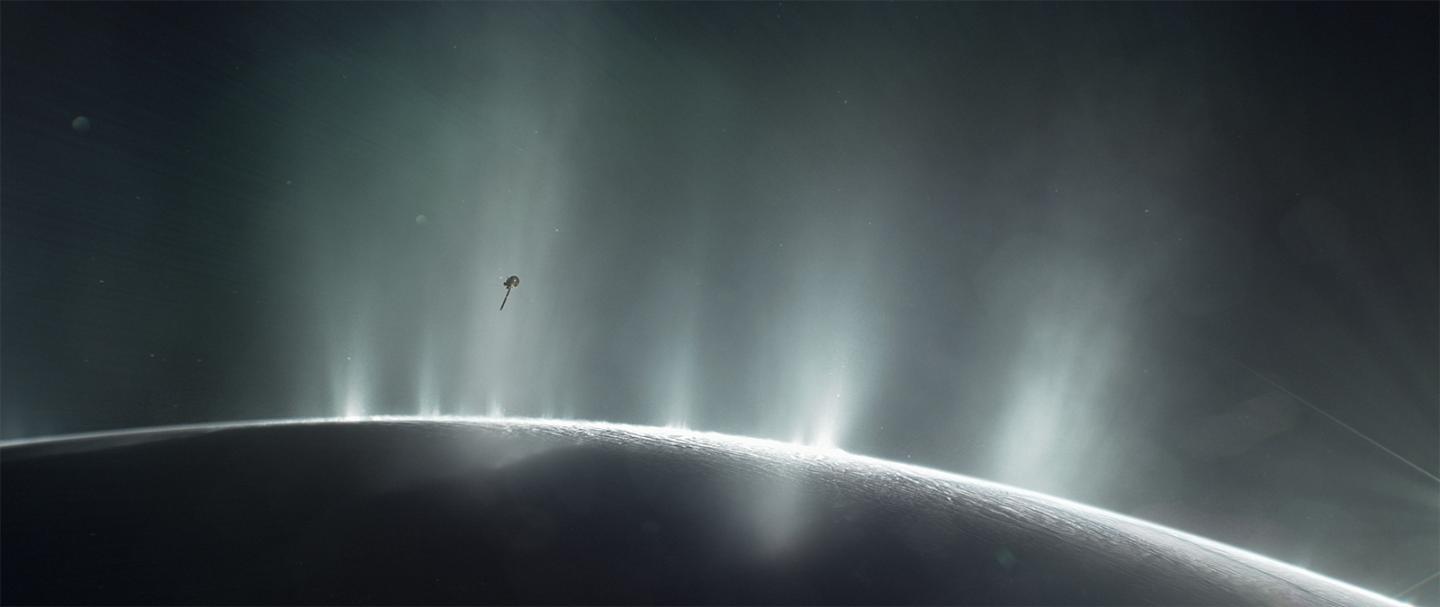Right now, our knowledge of ocean worlds is limited to moons like Enceladus around Saturn and Europa around Jupiter. Plumes of water erupt from Europa and Enceladus, so we can tell that these bodies have subsurface oceans beneath their ice shells, and they have energy that drives the plumes, which are two requirements for life as we know it
A new model estimated whether -- hypothetically -- there are planets similar to Europa and Enceladus in the Milky Way galaxy, and if they might be geologically active enough to shoot plumes through their surfaces that could one day be detected by telescopes.

NASA's Cassini spacecraft flying through plumes on Enceladus in October 2015, a graphical rendition. Credit: NASA/JPL-Caltech
Through a mathematical analysis of several dozen exoplanets, including planets in the nearby TRAPPIST-1 system, the authors learned something significant: More than a quarter of the exoplanets they studied could be ocean worlds, with a majority possibly harboring oceans beneath layers of surface ice, similar to Europa and Enceladus. Additionally, many of these planets could be releasing more energy than Europa and Enceladus. They selected 53 exoplanets with sizes most similar to Earth, though they could have up to eight times more mass. Scientists assume planets of this size are more solid than gaseous and, thus, more likely to support liquid water on or below their surfaces.
With their Earth-size planets identified, they sought to determine how much energy each one could be generating and releasing as heat. The team considered two primary sources of heat. The first, radiogenic heat, is generated over billions of years by the slow decay of radioactive materials in a planet's mantle and crust. That rate of decay depends on a planet's age and the mass of its mantle. Other scientists already had determined these relationships for Earth-size planets. So they applied the decay rate to their list of 53 planets, assuming each one is the same age as its star and that its mantle takes up the same proportion of the planet's volume as Earth's mantle does.

Next, the researchers calculated heat produced by something else: tidal force, which is energy generated from the gravitational tugging when one object orbits another. Planets in stretched out, or elliptical, orbits shift the distance between themselves and their stars as they circle them. This leads to changes in the gravitational force between the two objects and causes the planet to stretch, thereby generating heat. Eventually, the heat is lost to space through the surface.
One exit route for the heat is through volcanoes or cryovolcanoes. Another route is through tectonics, which is a geological process responsible for the movement of the outermost rocky or icy layer of a planet or moon. Whichever way the heat is discharged, knowing how much of it a planet pushes out is important because it could make or break habitability.
For instance, too much volcanic activity can turn a livable world into a molten nightmare. But too little activity can shut down the release of gases that make up an atmosphere, leaving a cold, barren surface. Just the right amount supports a livable, wet planet like Earth, or a possibly livable moon like Europa.

Scientists may one day be able to test these predictions by measuring the heat emitted from an exoplanet or by detecting volcanic or cryovolcanic (liquid or vapor instead of molten rock) eruptions in the wavelengths of light emitted by molecules in a planet's atmosphere. For now, scientists cannot see many exoplanets in any detail. Alas, they are too far away and too drowned out by the light of their stars. But by considering the only information available - exoplanet sizes, masses and distances from their stars - we can tap mathematical models and our understanding of the solar system to try to imagine the conditions that could be shaping exoplanets into livable worlds or not.
While the assumptions that go into these mathematical models are educated guesses, they can help scientists narrow the list of promising exoplanets to search for conditions favorable to life so that NASA's eternally upcoming James Webb Space Telescope or other space missions can follow up - assuming it works.





Comments